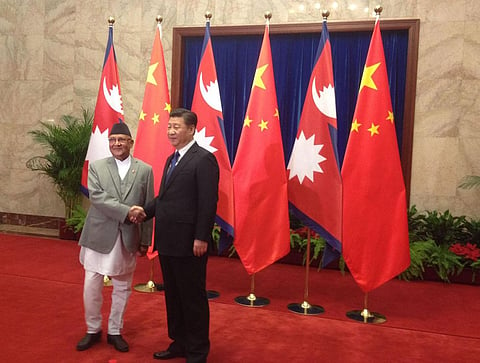
- Home
- न्यूजग्राम
- NewsGram USA
- India
- World
- Politics
- Entertainment
- Culture
- Lifestyle
- Economy
- Sports
- Sp. Coverage
- Misc.
- NewsGram Exclusive
- Jobs / Internships

Kathmandu, Nepal: With the signing of the Transit and Transportation Agreement between Nepal and China in Beijing, there is a sense of anxiety, worry and concern in Indian strategic circles about Nepal tilting towards China. Many have commented that this has ended India's long monopoly in Nepal in doing third country business through Indian ports and, overnight, Nepal will do business, import fuel from China and so on.
As a landlocked country, seeking transit rights is Nepal's fundamental right and, as of now, India and Bangladesh have provided such facilities to Nepal.
Realizing that Nepal will turn to China for transit and trade rights, India, during the visit of Nepalese Prime Minister K P Sharma Oli last month, had agreed to provide Visakhapatnam port for Nepal's use. As of now, Nepal is using only Haldia in Kolkata for third-country trade but it is smaller than Visakhapatnam. During the visit, India also allowed Nepal land transit via Bangladesh, implicit being that India was already aware that Nepal would turn to China.
It is being said that had India allowed Nepal this when it was proposed over a decade ago, Nepal would not have gone with China. Second, if India had not imposed an unofficial blockade, privileging one community and group's demand, Nepal would not have tilted towards China.
After signing the Transit Agreement with China, it is widely anticipated that Nepal will do business through Chinese ports and end its dependency on India. Such interpretations, particularly in Indian strategic circles, are beyond the ground realities and one should understand that a transit treaty does not necessarily measure up to implementation.
The poor infrastructure on the Nepali side, the difficult geographical terrain on both sides and without a rail link up to the Nepali border in Kerung (Gyirong in Chinese side), Nepal cannot immediately begin third country business through Chinese ports. Physical infrastructure on either side of the border is important for the full use of transit rights and, on the Nepali side, it will take years to upgrade Kerung, the only transit, transportation and trade route between Nepal and China.
Second, the nearest Chinese port is Tainjin which is 3,000 km from the Nepali border and the nearest Indian port is Haldia which is just 1,000 km away. This per se makes a huge difference in doing business in terms of costs, said Nepal's former commerce secretary Purusottam Oja.
If Nepal needs to do business through Tianjin port to Kerung, it is almost impossible to import goods via trucks or containers. The only option is to rail and Chinese officials say this will happen only by 2020.
"Of course, a further extension from Gyirong is an even longer-term plan. It's up to geographic and technical conditions and financing ability. We believe that far in the future the two countries will be connected by rail," Hou Yanqi, deputy head of the Chinese foreign ministry's Asia division, said in Beijing after the meeting between Oli and Premier Li Keqiang.
"Strategically it is going to be a good deal but due to distance per se, it is going to be a very costly affair for us until there is rail service from Tianjin to the Nepal border," said Oja. "It also depends on the status of infrastructure on both sides…and paperwork. Hassle free paperwork for customs and other purposes are key in transit rights," said Oja.
Another Nepal-China trading point, Tatopani, is shut down since April 25, 2015, earthquake and there is no official confirmation whether the Chinese side will open it up or not. In case China opens it, Nepali traders have to use trucks, containers and other light vehicles to import and export goods from Tianjin, again very costly for traders.
"I am not going to use and do business through Tianjin that is going to be three-fold expensive for us," said Indian trader Ravi Singh, who is engaged in third-country business.
"Without stressing on connectivity, the transit agreement will not be productive," said noted economist Bishamber Pyakurel.
"Neither it is a historic pact nor is it a non-workable one. Though it is a welcome move, its success lies in implementation," he said in an interaction with journalists.
It should also be remembered that Nepal is doing business with India through 24 small and big trading points whereas Nepal is doing business with China only through one trading point.
Then, India has also proposed to build five rail corridors with Nepal and one is proposed to connect Uttar Pradesh and Kathmandu.
The ground realities more than make clear that the 'China card' remains more of an illusion but Kathmandu has finally made the strategic move that New Delhi is bound to have taken note of. (IANS)
